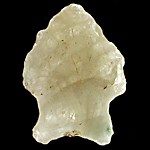|
As the Pleistocene Epoch drew to a close ten thousand years ago, and the rivers of glacial ice melted, people lived in an environment dramatically different from today—both cooler and wetter. Lakes and swamps existed where no water remains now. Lush grasslands covered the plains, supporting mammoths, mastodons, horses, camels, and, in some areas, bison.

Early Habitation The Campbells believed that there had been a river flowing through Pinto Basin but more recent research by geologists dispels the notion that there was either a river or a lake in Pinto Basin by the time humans occupied the area. The points collected by the Cambells are thick and triangular in shape, with notched shoulders and a broad stem. Pinto hunters attached the points to a wooden spear shaft and used a spear thrower, or atlatl, to propel the spear. Based on the relatively large number of Pinto points—as well as cutting and scraping tools—compared with the few seed-processing implements found at these early sites, it is believed that Pinto Culture was a mobile population dependent upon large game hunting and seasonal plant gathering. The period of Pinto Culture occupation was an era of decreasing moisture, and by the end the environment was probably close to what we have today. As the Pleistocene water sources dried up, only desert adapted plants and animals survived. The archeological evidence suggests that the human population gradually adapted as well, by hunting smaller game and processing small seeds. Today’s Tribal Groups |
Last updated: November 7, 2023
